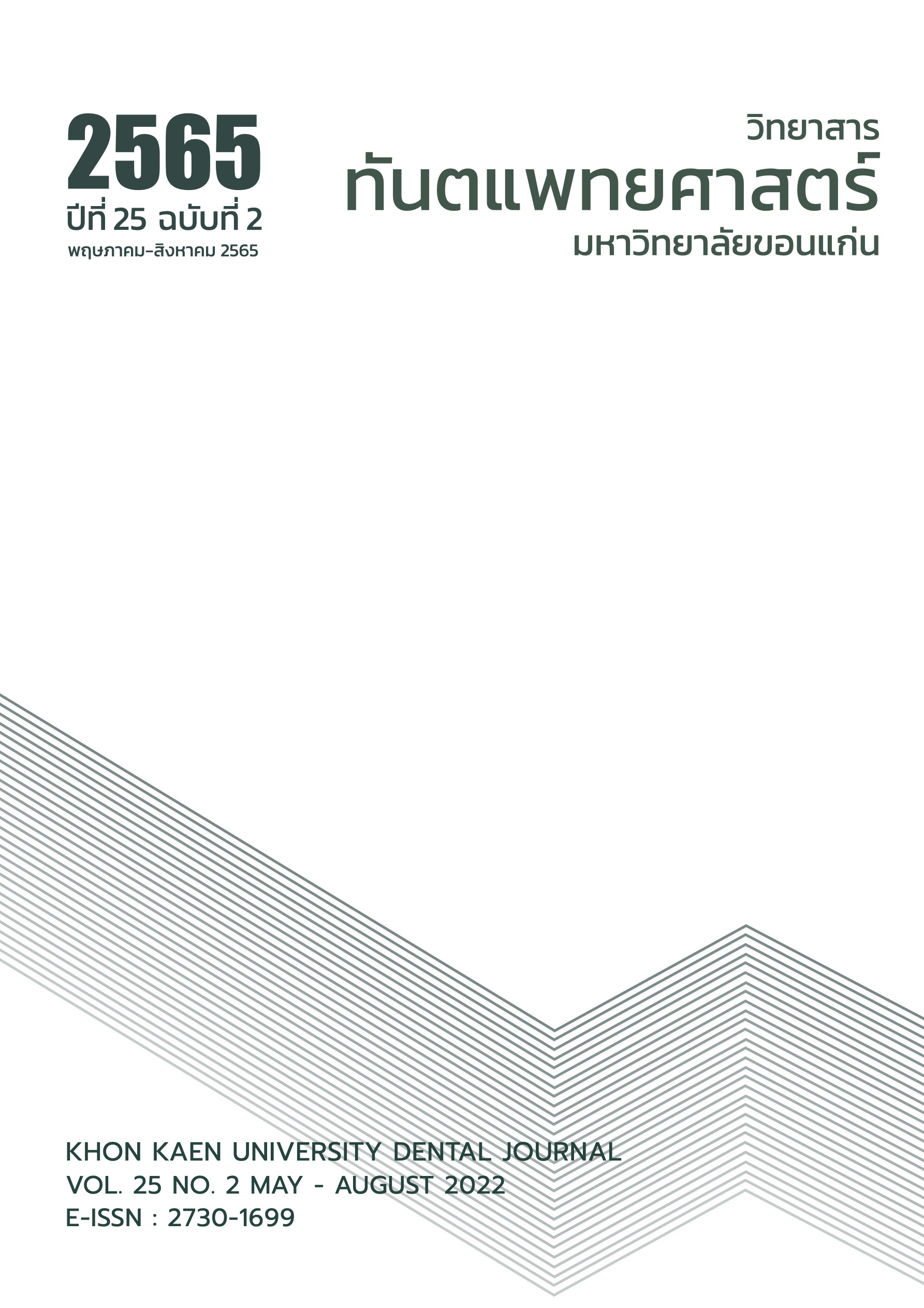Oral Health Situation and Smoking of Novices in the General Education Section of Phrapariyattidhamma Schools in the Border Districts, Chiang Mai Province
Main Article Content
Abstract
Scrutinization and oversight of oral health conditions amongst members of the Buddhist novitiate has been neglected. The goal of this research was to investigate the status of oral health and smoking behaviours of members of the novitiate at Phrapariyattidhamma School, in the border district of Chiang Mai Province. This was a cross-sectional descriptive study, conducted between September 2019 and September 2020. This study consisted of quantitative study involving 303 novices, ages 12-20 years. Data concerning dental caries and periodontal conditions was gathered via an oral health examination. Smoking behavior data was gathered via questionnaire. The data was analyzed within the parameters of descriptive statistical method, employing percentage, mean and standard deviation. Qualitative method was consisting of both observation and in-depth interviews with 16 novices and 1 teacher about smoking behaviour and socio-cultural context of novices. Results showed that the DMFT mean was 3.7±3.2, the gingival index mean was 1.5±0.3 and the simplified oral hygiene index came in at 2.8±1.2. While 16.8% of the novices were still smokers and 22.4 % had had a history of smoking. These percentages displayed the higher range, compared with 15-year-old children from 8th Thailand National Oral Health Survey. Therefore, we considered smoking to be a very important problem in oral health situation. Using qualitative data-collection methods on smoking, we discovered that social structure, social control, socio-cultural, environment and attitude of novices was important to smoking behaviour of novices. In summary, incessant smoking was an important contributor to the problems of oral health amongst the novitiate. Thus, it is urgent that a resolution of the problems need to be considered.
Article Details

This work is licensed under a Creative Commons Attribution-NonCommercial-NoDerivatives 4.0 International License.
บทความ ข้อมูล เนื้อหา รูปภาพ ฯลฯ ที่ได้รับการลงตีพิมพ์ในวิทยาสารทันตแพทยศาสตร์ มหาวิทยาลัยขอนแก่นถือเป็นลิขสิทธิ์เฉพาะของคณะทันตแพทยศาสตร์ มหาวิทยาลัยขอนแก่น หากบุคคลหรือหน่วยงานใดต้องการนำทั้งหมดหรือส่วนหนึ่งส่วนใดไปเผยแพร่ต่อหรือเพื่อกระทำการใด ๆ จะต้องได้รับอนุญาตเป็นลายลักษณ์อักษร จากคณะทันตแพทยศาสตร์ มหาวิทยาลัยขอนแก่นก่อนเท่านั้น
References
Nandadhammiko B, Dhammahaso H. An analytical study of a model of cho sa-ard novice development. JMPS 2019;7(Supplement):208-23.
Klunklin P, Thaiyapirom N, Chinnaphatho C. The development process of health promotion for novices in somdej phra buddha chinawong school. Nursing J 2013;40(Supplement):57-66.
Andersen RM, Davidson PL. Ethnicity, aging, and oral health outcomes: a conceptual framework. Adv Dent Res 1997;11(2):203-9.
Wilson FA, Wang Y, Borrell LN, Bae S, Stimpson JP. Disparities in oral health by immigration status in the United States. J Am Dent Assoc 2018; 149(6):414-21.
Marthaler TM. Changes in dental caries 1953-2003. Caries Res 2004;38(3):173-81.
Clinical Affairs Committee AAoPD. Guideline on adolescent oral health care. Pediatr Dent 2015; 37(5):49-56.
Dental Health Bureau. The 8th National oral health survey report, 2017. Bangkok: Samcharoen Panich (Bangkok) Co., Ltd.;2018.43-87.
Saibiaw W. Relationship between knowledge, attitude, self-efficacy and behavior of dental care with dental caries status among novice in phrapariyattidham school, changwat nakhon si thammarat [thesis]. Trang: Sirindhorn College of Public Health, Trang; 2020.
World Health Organization. Adolescents: health risks and solutions [homepage on the Internet]. Geneva: World Health Organization[cited 2019 Aug 25]. Available from: https://www.who.int/ news-room/fact-sheets/detail/adolescents-health-risks-and-solutions.
World Health Organization. WHO monograph on tobacco cessation and oral health integration. [monograph on the Internet] Geneva: WHO Press; 2017 [cited 2019 Aug 24]. Available from: https://www.who.int/publications/i/item/who-monograph-on-tobacco-cessation-and-oral-health-integration
Petersen PE, Baez RJ, World Health Organization. Oral health surveys: basic methods - 5th edition [monograph on the Internet] Geneva: WHO Press; 2013 [cited 2019 Aug 20]. Available from: https://apps.who.int/iris/handle/10665/97035.
Löe H, Silness J. Periodontal disease in pregnancy. I. Prevalence and severity. Acta Odontol Scand
;21:533-51.
Greene J, Vermillion J. The simplified oral hygiene index. J Am Dent Assoc 1964;68:7-13.
Cheawjindakarn B. Qualitative Case Study Research Techniques. LARHCU 2018;13(25):103-18.
Margulies E. Why i smoke: sociology of a deadly habit. Human Architecture: Journal of the Sociology of Self-Knowledge 2003;2(1):Article 2.
Freire P. Pedagogy of the oppressed. New York: Seabury Press 1968.
Dodd VJ, Logan H, Brown CD, Calderon A, Catalanotto F. Perceptions of oral health, preventive care, and care-seeking behaviors among rural adolescents. J Sch Health 2014;84(12):802-9.
Sukhabogi JR, Shekar CBR, Hameed IA, Ramana IV, Sandhu G. Oral health status among 12- and 15-year-old children from government and private schools in hyderabad, andhra pradesh, india. Ann Med Health Sci Res 2014;4(Suppl 3):S272-7.
Kukletova M, Izakovicova Holla L, Musilova K, Broukal Z, Kukla L. Relationship between gingivitis severity, caries experience and orthodontic anomalies in 13-15 year-old adolescents in Brno, Czech Republic. Community Dent Health 2012; 29(2):179-83.
Lekfuangfu P. The effectiveness of plaque control programme in adolescents, Wat Rajathivas public secondary school Bangkok Thailand [thesis]. Bankok: Chulalongkorn University; 1996.
Kaewsutha N, Intarakamhang U, Duangcha P. The causal factors of oral health care behavior of early adolescents. TJBS 2013;19(2):153-64.
Kungskulniti N, Charoenca N, Kengganpanich T, Kusolwisitkul W, Pichainarong N, Kerdmongkol P, et al. Smoking prevalence among monks in Thailand. Eval Health Prof 2012;35(3):305-22.
Abhinandho P, Dhanabhaddo P, Noonklum D, Chimhad, P. A study of guildline the policy to non-smoking temple of sangha organization in the area of muang trang district, trang province. JMND 2021;8(5):87-102.
Al-Sheyab NA, Alomari MA. Unhealthy eating habits among adolescent waterpipe smokers in Jordan: The Irbid-TRY study. Tob Induc Dis 2018; 16:19.
Davey G, Zhao X. Turning points to becoming a tobacco smoker: smoking initiation and identity change among chinese youth. Symb Interact 2019;43(2):308-31.
Tsai AC, Papachristos AV. From social networks to health: Durkheim after the turn of the millennium. Introduction. Soc Sci Med 2015;125:1-7.
Jemal A. Critical Consciousness: A critique and critical analysis of the literature. Urban Rev 2017;49(4):602-26.
Tirukkovalluri SS, Arumugam B, Gunasekharan N, Suganya E, TAkhshaya Ponsuba T, Divyadharshini S. Social determinants in access to tobacco prevention and cessation support services among migrant construction workers in Urban Chennai, India. J Family Med Prim Care 2020;9(4):1991-8.
Wattanawilai C, Rakpuangchon W. Smoking motivation and non-smoking intention among boy students with a smoking family member. JFONUBUU 2018;26(1):20-8.
Rajczi A. Liberalism and public health ethics. Bioethics 2016;30(2):96-108.
Welkom JS, Riekert KA, Rand CS, Eakin MN. Associations between caregiver health literacy and preschool children's secondhand smoke exposure. J Pediatr Psychol 2016;41(4):462-72.


